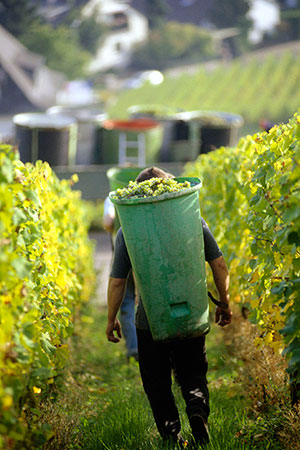Our vineyards need Mexican labor

Reader opinion by Bill Boerum — Having conducted wine tours for over 10 years and observing our scenic vineyards, it’s been of interest to me to learn about the work done by migrant labor, the major labor input to cultivation and harvesting.

What has been happening in the vineyards as well as in the fields of other crops of the mighty California agriculture industry — and across the U.S. ag sector — has been a developing scarcity of migrant labor. For a “white paper” on this issue I interviewed a cross section of wine industry participants. Everyone interviewed attested to the growing scarcity of field workers and the loss of reliable, experienced, well-trained laborers. Accompanying this has been an increase in cost to the grower. In a wider context, the latter exerts pressure on the American consumer’s low-cost fruits and vegetables. More specifically, hourly labor rates are rising in California’s vineyards. Migrant, seasonal labor has kept prices low. More than one source said California agriculture was built on “cheap labor,” a factor that the average consumer does not fully appreciate.
The factors producing the scarcity of migrant labor include: more effective border control in recent years; migrant workers are apprehensive, feeling hostility in the U.S.; improved economic conditions in Mexico not warranting the personal risks and costs of migration; competition from other industries, particularly construction but also the visitor and hospitality industry; the burdensome application process for the H-2A visa, work permits and for green cards; and, emerging competition from the cannabis industry.
Growers prefer the annual return of the same crews with their skills and reliability. In recent years, one grower has had to supplement its regular crews with H-2A visa qualified laborers when older and experienced workers do not return. Recruiting labor is an arduous task seeking out where there is labor available in Mexico. Most such workers are non-English speaking from remote Mexican villages.
At the risk of over-generalizing, I will say that agricultural migrant labor has been sourced through four means. First, green card holders who move back and forth across the border are a source. The “green card” permits permanent residency and work in the U.S. Getting a “green card” can take years.
 Next, the H-2A visa work permit, administered by the U.S. Department of Labor involves a months’ long process in anticipation of the need. There are obligations on the employer to provide inbound and outbound transportation from Mexico; housing; and food or kitchen facilities. Every employer I spoke to complained about the burdensomeness of the H-2A program. There are regulations on the minimum hourly rate of pay, the “Adverse Effect Wage Rate,” which in effect protects American workers by not allowing hourly rates below the AEWR thus propping up to an extent the migrant’s hourly pay above minimum wages.
Next, the H-2A visa work permit, administered by the U.S. Department of Labor involves a months’ long process in anticipation of the need. There are obligations on the employer to provide inbound and outbound transportation from Mexico; housing; and food or kitchen facilities. Every employer I spoke to complained about the burdensomeness of the H-2A program. There are regulations on the minimum hourly rate of pay, the “Adverse Effect Wage Rate,” which in effect protects American workers by not allowing hourly rates below the AEWR thus propping up to an extent the migrant’s hourly pay above minimum wages.
Thirdly, farm labor contractors recruit crews and handle the documentation easing the burden on growers. The California Farm Labor Contractors Association supports its members dealing with regulatory matters and providing advocacy. This week the association is conducting its fourth annual “Nor Cal Ag Labor Management Forum.” There is a session on the “adventures” of H-2A program
Finally, it was admitted to me that California agriculture was built on the backs of undocumented (illegal) workers. My research did not deal with the current extent of this. Grape growers I spoke to said all of their workers are legal that being the case throughout Napa and Sonoma.
Labor rates for any kind of skill in vineyard and winery work are creeping higher. Currently, rates are about $16 plus per hour as a starting wage in Napa and Sonoma. If a worker is not under the H-2A visa program, then deductions are taken and the employer has to pay FICA, do the paperwork, and transfer the money adding to the cost of labor pushing it up effectively to $19. Such workers are paid by check, no longer in cash.
The current national debate in the U.S. on immigration is ensnared in political and emotional issues around: DACA (the “dreamers”); chain migration (family unification); the lottery system (far too many applicants where the winners are not necessarily fully vetted); and the border wall. Compelling issues such as student visas, high tech and professional work visas; and of course, the migrant workforce challenge, do not seem to be getting attention. No one I spoke to – including a congressional office – was aware if these issues were in fact on the legislative docket for attention in either the House or the Senate.
Recently, I spoke at a conference in Guadalajara, Mexico dealing with issues between our countries. During the session on immigration I brought up the migrant labor issue and announced release of my white paper on this subject. Migrant labor needs attention on both sides of the border.
Bill Boerum, a wine tour operator lives in Sonoma, and is a publicly-elected trustee of the Sonoma Valley Health Care District. He can be reached at [email protected]

2 thoughts on “Our vineyards need Mexican labor”
Comments are closed.




Sorry — No Ag worker is taking home $16/hr, not after deductions for taxes, etc., and after the labor contractor takes his cut.
But the 13th amendment that supposedly ended slavery in the US has an interesting but seldom mentioned ‘exception’ that has caught the attention of Big Ag:
“Neither slavery nor involuntary servitude, except as a punishment for crime whereof the party shall have been duly convicted, shall exist within the United States, or any place subject to their jurisdiction.”
Big Ag is increasingly using prison slave labor. Jeff Sessions and the Republicans want to keep filling our prisons to the roof with black and brown people who have committed even minor offenses and who can’t afford bail, so that when that Wall gets built Big Ag will still have plenty of farm workers who don’t need H-2A visas and who don’t have to be paid at all.
My labor contractor pays his workers $12.50 an hour. They also get disability insurance and some health care coverage. I am charged $12.50 + 38% ($17.25) , to cover the contractors profit and benefits to the workers. This bae wage goes up every year. The price of my grapes is controlled by the buyers, they are a commodity. Just as an aside, in Paso Robles, CA, MacDonalds and Carl’s Junior are paying $12.00 and hour to start, with X benefits.